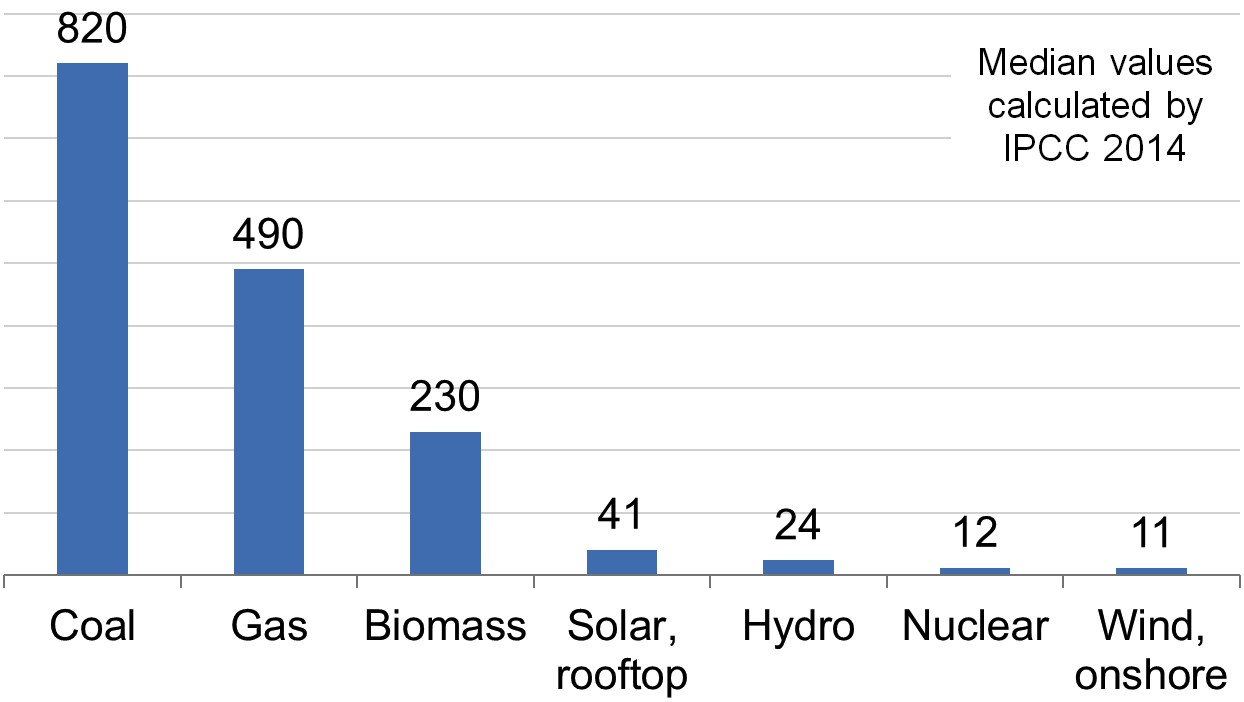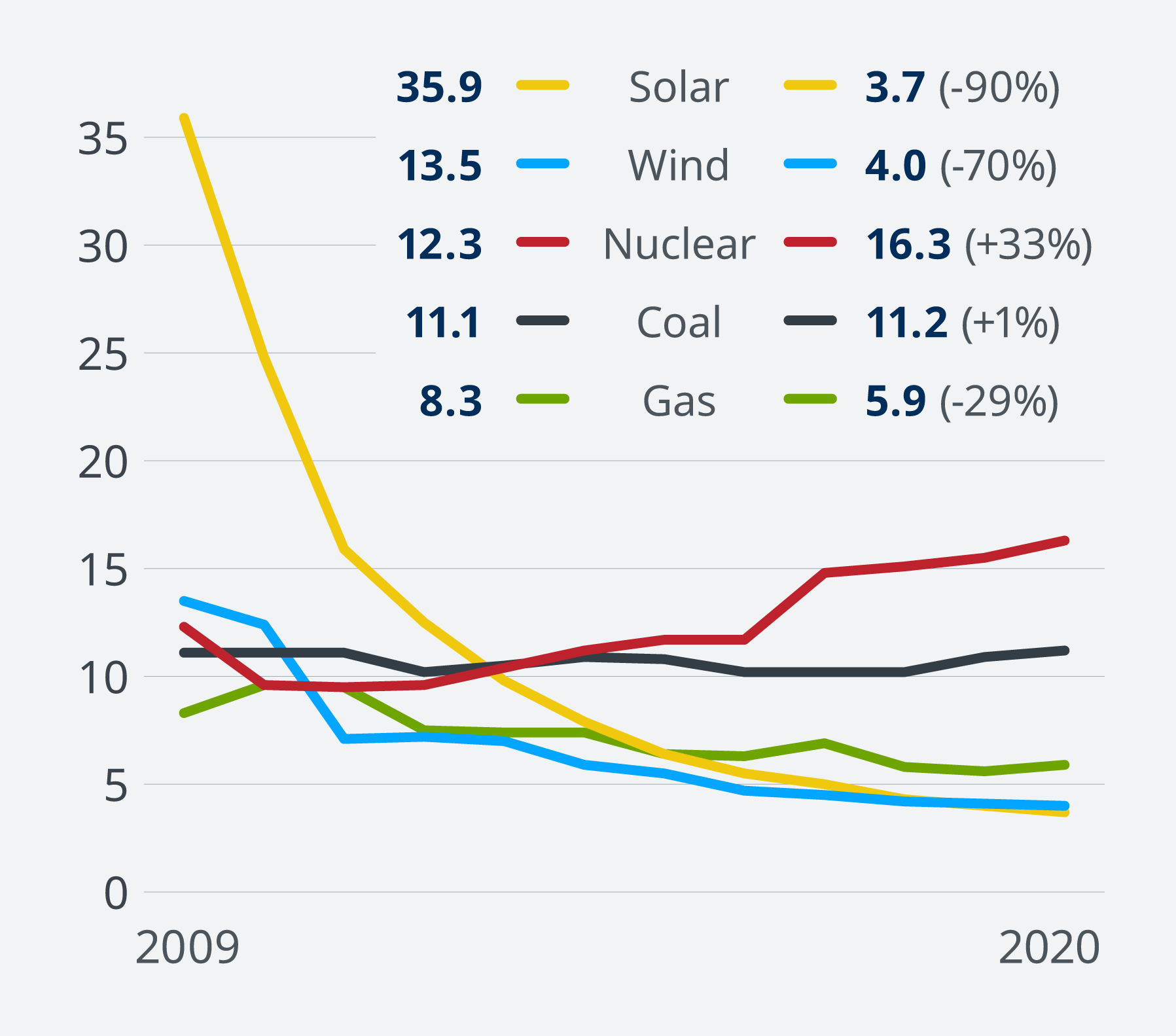- 7 min
The 7 pros and cons of nuclear energy
Whether to support nuclear (fission) energy to reduce our fossil fuel usage and counter climate change is a contentious issue. Here we won’t tell you what to support but will show you the most important arguments from both sides. This way, depending on which arguments are most important to you, you can make a more informed decision about which ideas to support in elections:
1. Carbon emissions and the environment
PRO – Nuclear power plants don’t emit greenhouse gasses, and can reliably replace gas, oil and coal power plants to counter climate change
A nuclear power plant uses tiny amounts of uranium as its fuel and doesn’t emit greenhouse gasses while in operation. Even if you include the extensive construction and decommissioning of the plant, the amount of greenhouse gasses produced per kWh is roughly equal to that of a windturbine and slightly lower than that of a solar panel.

CON – Nuclear reactors produce toxic radioactive waste
Even if you only used nuclear power, the amount of radioactive waste produced per person is tiny, but it still adds up: Currently humanity produced over 300,000 tonnes of nuclear waste, which is stored in 14 countries around the world – sometimes under questionable conditions according to Greenpeace1.
Some of that waste decays quickly, but about 3% is highly toxic for many thousands of years. While there are techniques to reduce the amount of waste, these are currently sparsely used. Newer techniques in development, for instance thorium reactors, might reduce it even further, but are likely still decades away from being widely adopted.
2. The race to reach climate goals
PRO – So far we are behind on the global climate goals and nuclear power could be an extra tool to get back on track
The effects of climate change are getting worse by the day and we are far off from limiting global warming to the 1.5 degrees Celsius scientists have considered to be relatively safe (but not without consequence). While solar, wind, water and geothermal energy sources can be deployed quickly, our capacity to do so has not been sufficient. Therefore it deserves at least our consideration to invest more heavily in nuclear power to get back on track.
CON – It takes a long time to build a nuclear power plant
Historically nuclear power plants have taken on average about 8 years to build and bring online, some even more than 12 years2. But that is after all decisions have been taken and approval processes have been cleared. So even if there was all the required political will to massively invest in nuclear power plants today, we would not see the effects of it until after 2030. The year that is the main target for international climate goals.
Wind and solar are comparatively much faster to deploy and often most of the time is not used to build it, but to deal with approval processes.
3. Safety
PRO – Nuclear reactors have gotten much safer since Chernobyl
The biggest nuclear disaster happened in Chernobyl in 1986 because of reactor design flaws and multiple layers of human error, brilliantly depicted in the HBO series ‘Chernobyl‘. The second biggest nuclear disaster happened in 2011 in Fukushima due to a Tsunami which disabled the cooling. Compared to the 8 million deaths a year attributed to burning fossil fuels3, the numbers of casualties were relatively low: Chernobyl caused less than 100 direct deaths and an unknown but estimated number in the thousands indirect deaths. For Fukushima no deaths have been recorded.
Both reactors were from the 70’s and since then reactor designs have been greatly improved and now even safer Generation IV designs are being developed. If these newer designs are placed in geographically safe locations with decent management, the risks of environmental hazards should be incredibly small compared to Fukushima and Chernobyl.
CON – If we deploy nuclear energy on a larger scale, accidents become more likely
While nuclear reactors have gotten safer, there is still a danger in large numbers. Increasing the number of reactors in geographically unsafe or potential warzones could create unforeseen circumstances.
If this is avoided there is still the danger of the highly toxic nuclear waste. Even though there are strict guidelines, if countries improperly manage this it could cause disasters by either leaking into the environment or by terrorists using it to create a ‘dirty bomb’: an explosive containing nuclear waste.
A likely indirect effect is that countries with a lot of nuclear reactors and nuclear waste have a greater need to protect themselves from harm. Therefore governments have powerful reasons for further reaching and stronger security programs and invasions of privacy.
4. Reliability
PRO – The steadiness of nuclear power is helpful because solar and wind power is unreliable
No solar power without sun, no wind power without wind. While nuclear power can’t be quickly increased or decreased like a gas-fired power plant, it does help to provide a more stable power supply. Especially in the mornings and evenings it would come in helpful when solar energy is low, but electricity consumption is highest.
CON – Batteries help us to make power from the sun and wind steady and reliable.
Batteries and other energy storage solutions can store the energy from the wind and sun and supply it in the demanding mornings and evenings. Battery production is not sufficient to do this at a massive scale yet, but huge investments are being made. Also batteries without the use of rare, often harmfully extracted materials like cobalt are being used and developed more and more, so their environmental impact should decrease over time.
5. Cost
PRO – Nuclear power prices might come down as scale goes up
While the costs of nuclear power are high, investing more in the sector could theoretically bring prices down in the long run as the technologies advance and economies of scale kick in.
CON – Nuclear power’s cost has been rising steadily
As the price of solar and wind has dropped steadily in the last 20 years, the cost of nuclear power has gone up significantly. Innovations over the last 50 years have made the reactors safer, but didn’t make them more cost effective. In 2020 the cost of solar and wind power is over three times cheaper per watt than that of a new nuclear power plant.

6. Dependency on big business and other countries
PRO – Nuclear energy will make us less dependent on fossil fuels from other countries and big fossil fuel companies
It is a potential hazard to be dependent on fossil fuels from other countries. Access to fossil fuels can be used to put political pressure against you or in the case of Russia, even to fund wars you abhor.
And dependency on big, profit driven fossil fuel companies can lead to environmentally harmful decisions too. Therefore the more nuclear power we generate, the less we are dependent on fossil fuel supply from big business and other countries so that international tensions calm down.
CON – Uranium dependency on other countries is far from ideal and could increase international tensions
Just like there is a limited supply of fossil fuels, there is a limited supply of Uranium in the world as well. About 96% of the known uranium is found in these 10 countries: Australia, Canada, Kazakhstan, South Africa, Brazil, Namibia, Uzbekistan, the United States, Niger, and Russia. So by increasing the amount of nuclear energy, we become more dependent on those countries that have access to it, which could increase tensions.
Additionally there are not that many companies that regularly build nuclear power reactors, with 5 main ones doing most of the construction work. Increasing our reliance on nuclear power, would increase our reliance on these big profit driven businesses. Solar and wind are much easier to produce and it’s much easier for new companies to enter the space.
7. Future generations
PRO – Nuclear power can reduce the threat of a climate catastrophe for many generations, while the risks have so far shown to be small
It is hard to compare the risks, but it can be argued that climate change is already proving to have a negative impact of massive proportions for future generations, while so far the negative impact of nuclear power, which could theoretically be massive as well, has been relatively small in reality.
Additionally we will likely to be able to use nuclear power for quite some time, though not indefinitely. With current technology and at the current nuclear energy usage the global supply of uranium would last at least 200 years. With breeder reactors that recycle the fuel (but also create more radioactive waste), at least 30,000 years. Additionally there is 4.5 billion tons of uranium in our oceans. While it might be difficult or impossible to extract large amounts of it, it’s theoretically good for another 30,000 years of power at the current rate.
However, when looking at these numbers we need to keep in mind that currently just 10% of the global energy supply comes from nuclear, and our energy needs are increasing. So theoretically these number have to be divided by at least a factor of 10 if we were to fully rely on nuclear.
CON – Nuclear power is not a final solution because it’s not renewable and leaving radioactive waste for future generations isn’t ethically ideal
The only true long term solution to the climate crisis is an energy source that is renewable and sustainable. Nuclear fission power in its current form isn’t, so at most it will only be a temporary fix. Advancements in nuclear fusion power might offer a sustainable solution without radioactive waste, but the technology is famously always 30 years away.
Apart from that likely most people in the world believe it is ethically desired to leave as little of a mess to future generations as possible, and dealing with radioactive waste and other negative effects mentioned earlier can be profoundly messy.
The next step towards a sustainable life
By letting us plant trees for you in Tanzania to offset your carbon footprint you also get access to the program ‘In harmony with earth’ where you learn more and more about what are the most environmentally friendly choices to make in life. Just like in this article we won’t just preach, but will give you the background to make up your own mind, so order your trees now: